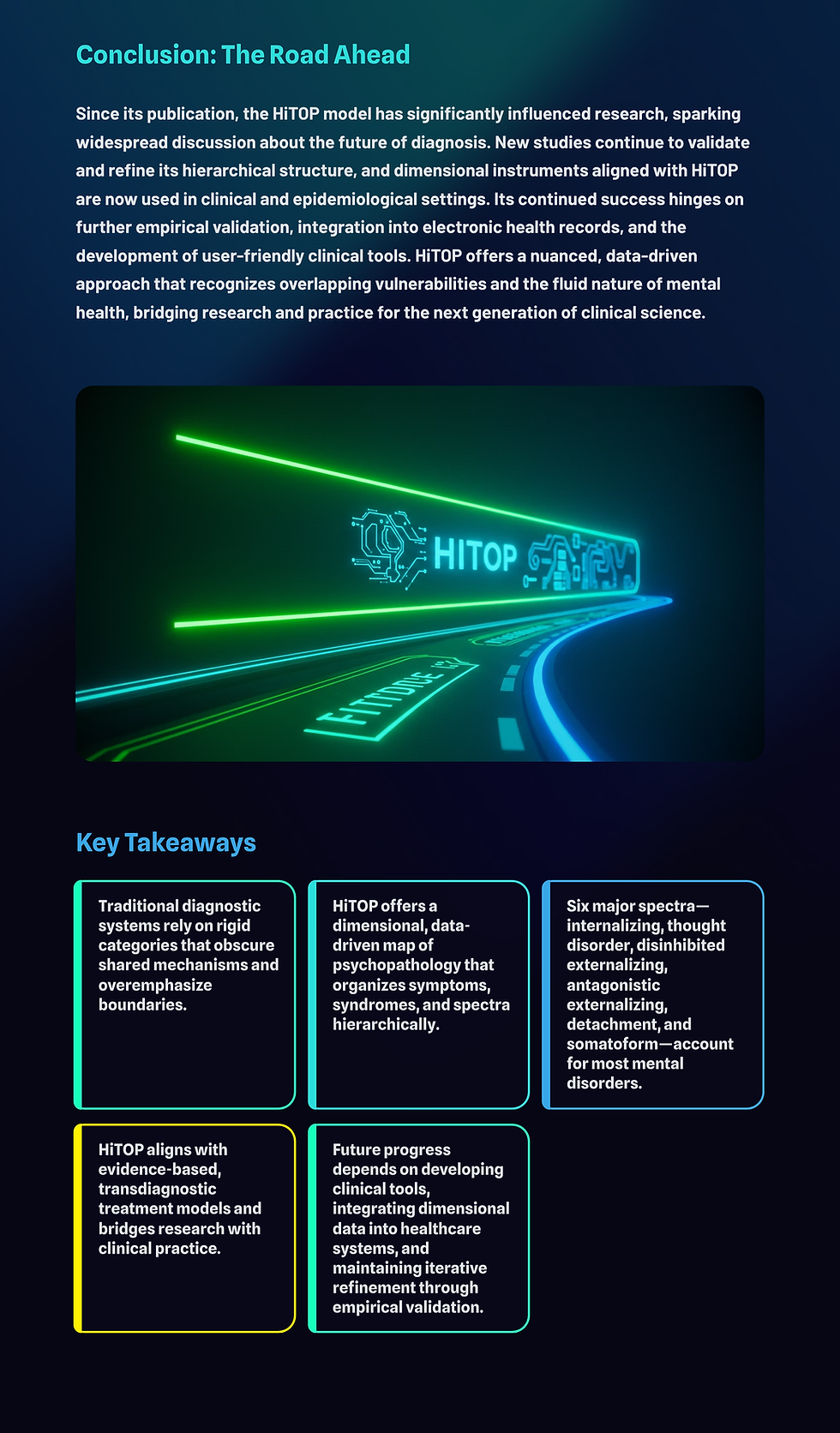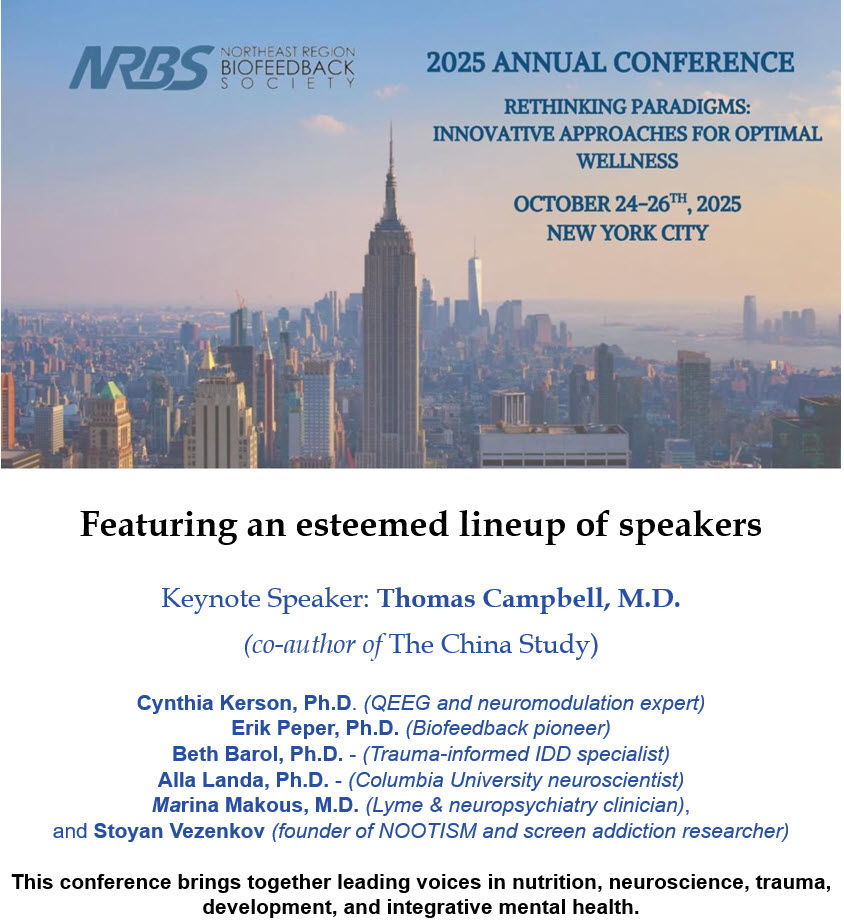HiTOP: Rethinking Diagnosis Through a Dimensional Lens
- Zachary Meehan

- Oct 18
- 5 min read

Understanding the Problem: Limits of Traditional Diagnostics
For decades, psychiatric diagnosis has relied on categorical systems such as the DSM and ICD. These frameworks divide mental disorders into discrete entities. Although these systems have standardized communication and improved reliability, their conceptual foundation remains limited.
Traditional taxonomies treat disorders as separate categories rather than points along a continuum. This approach creates artificial boundaries between normal and pathological experiences, contributing to diagnostic instability and heterogeneity within disorders. Two individuals with “major depressive disorder,” for example, may share a few overlapping symptoms. What’s more, the factors driving the illness can vary from biological to interpersonal.
Equally problematic is the high rate of comorbidity: anxiety, mood, and substance use disorders frequently co-occur, suggesting shared underlying mechanisms. Moreover, many individuals experience substantial distress and impairment without meeting criteria for any specific diagnosis. These gaps leave clinicians without clear guidance for treatment and complicate efforts to connect diagnosis to etiology or outcome.
Kotov and colleagues (2017) argue that these limitations stem from a lack of empirical grounding in how symptoms naturally cluster and co-vary across populations. In response, they propose a new framework—the Hierarchical Taxonomy of Psychopathology (HiTOP)—to build a more valid and clinically useful system for understanding mental disorders.
HiTOP as a Dimensional Alternative
The Hierarchical Taxonomy of Psychopathology (HiTOP) model replaces arbitrary diagnostic categories with empirically derived dimensions based on how symptoms actually group in real-world data.
At its core, HiTOP organizes psychopathology hierarchically. Narrow, homogeneous symptom clusters (e.g., panic attacks, social fears) combine to form syndromes (e.g., social anxiety), which then group into broader spectra (e.g., internalizing). These spectra reflect shared risk factors and biological or psychological liabilities.
Research has identified at least six major spectra:
Internalizing (anxiety, depression, distress)
Thought disorder (psychosis, bipolar I)
Disinhibited externalizing (impulsivity, substance use)
Antagonistic externalizing (aggression, narcissism)
Detachment (social withdrawal)
Somatoform (health anxiety, pain syndromes)
These dimensions are themselves correlated, giving rise to a broader, overarching “p factor” that captures general liability toward psychopathology—akin to a “general factor” of mental illness.
This structure integrates decades of evidence from personality, developmental, and clinical research, offering a unified dimensional map of psychological dysfunction that explains both comorbidity and individual differences in symptom expression.
The Method Behind the HiTOP Model
HiTOP was built through the quantitative classification movement, a decades-long effort to empirically determine the structure of mental illness using statistical tools such as factor analysis.
Rather than defining disorders by expert consensus, researchers analyzed large datasets of symptoms, behaviors, and diagnoses to identify naturally occurring patterns. Across cultures and samples, these analyses consistently yielded the same dimensional organization.
The model continues to evolve through international collaboration, refining which symptoms belong to which spectra and developing reliable dimensional measures that clinicians and researchers can use to assess each level—from specific symptom clusters to broader transdiagnostic dimensions.
Clinical Implications and Real-World Use of the HiTop Model
For clinicians, the question remains: Can a dimensional system guide real-world decisions? The authors argue yes, and point to several clear advantages.
HiTOP offers a way to quantify severity and complexity. Much like medical metrics for blood pressure or glucose, dimensional scores can be translated into practical thresholds for intervention intensity. Rather than a binary diagnosis (“has it or not”), clinicians can describe clients along continua—low, moderate, or high on internalizing, for instance—and use that profile to guide individualized treatment planning.
Moreover, clinicians are already familiar with dimensional tools such as the MMPI, PAI, and Achenbach System of Empirically Based Assessment. HiTOP builds on this tradition by aligning measurement with a scientifically validated structure of mental illness. This approach helps to clarify why disorders co-occur, supports transdiagnostic treatment models, and strengthens links between assessment, case formulation, and outcome prediction.
HiTOP also has implications for research translation. Because it captures shared variance across traditional diagnoses, it provides a more powerful framework for studying mechanisms, biomarkers, and treatment response—areas where categorical systems have historically struggled.
Integration and Relation to Other Frameworks
HiTOP complements other dimensional efforts such as the Research Domain Criteria (RDoC) initiative by the National Institute of Mental Health. Whereas RDoC emphasizes biological and behavioral systems (e.g., neural circuitry, genetics), HiTOP focuses on phenotypic organization—how symptoms manifest and cluster in people.
Together, the two frameworks can inform one another: HiTOP defines the clinical expression of psychopathology, and RDoC investigates its underlying mechanisms. Clinically, HiTOP provides a bridge between neuroscience and applied assessment, translating dimensional science into language and tools that clinicians can use.
Conclusion: The Road Ahead
Since its publication in 2017, the HiTOP model has significantly influenced research, sparking widespread discussion about the future of diagnosis. New studies continue to validate and refine its hierarchical structure, and dimensional instruments aligned with HiTOP are now being used in both clinical and epidemiological settings.
Still, HiTOP is best viewed as a work in progress rather than a finished taxonomy. Its success depends on continued empirical validation, integration into electronic health records, and development of user-friendly clinical tools that translate dimensional data into treatment-relevant guidance.
For clinicians, HiTOP represents both a challenge and an opportunity. It challenges long-held habits of categorical labeling, but it also offers a more nuanced, data-driven way to understand patients—one that recognizes overlapping vulnerabilities, shared etiologies, and the fluid nature of mental health and illness. As the field moves toward dimensional approaches, HiTOP stands as one of the most promising frameworks for bridging research and practice in the next generation of clinical science.
Key Takeaways
Traditional diagnostic systems rely on rigid categories that obscure shared mechanisms and overemphasize boundaries.
HiTOP offers a dimensional, data-driven map of psychopathology that organizes symptoms, syndromes, and spectra hierarchically.
Six major spectra—internalizing, thought disorder, disinhibited externalizing, antagonistic externalizing, detachment, and somatoform—account for most mental disorders.
HiTOP aligns with evidence-based, transdiagnostic treatment models and bridges research with clinical practice.
Future progress depends on developing clinical tools, integrating dimensional data into healthcare systems, and maintaining iterative refinement through empirical validation.




Glossary
comorbidity: the co-occurrence of multiple disorders or symptom clusters in the same individual. dimensional classification: an approach viewing mental disorders as continua of severity rather than discrete types.
factor analysis: a statistical method identifying latent dimensions based on patterns of covariation.
HiTOP: Hierarchical Taxonomy of Psychopathology; a dimensional classification model for mental disorders.
p factor: a general factor representing shared vulnerability across psychopathology.
quantitative nosology: an empirically derived classification system based on observed data rather than expert consensus.
Research Domain Criteria (RDoC): a framework developed by the U.S. National Institute of Mental Health (NIMH) that seeks to classify mental functions and disorders based on dimensions of observable behavior and neurobiological measures, rather than traditional symptom-based categories. RDoC organizes mental processes into domains (e.g., negative valence, cognitive systems, arousal/regulatory systems) and units of analysis (e.g., genes, molecules, circuits, behavior) to bridge neuroscience and psychology in understanding mental health. spectrum: a broad grouping of related syndromes (e.g., internalizing, externalizing). subfactor: a narrower cluster within a spectrum (e.g., fear vs. distress under internalizing).
Reference
Kotov, R., Krueger, R. F., Watson, D., Achenbach, T. M., Althoff, R. R., Bagby, R. M., Brown, T. A., Carpenter, W. T., Caspi, A., Clark, L. A., Eaton, N. R., Forbes, M. K., Forbush, K. T., Goldberg, D., Hasin, D., Hyman, S. E., Ivanova, M. Y., Lynam, D. R., Markon, K., Miller, J. D., … Zimmerman, M. (2017). The Hierarchical Taxonomy of Psychopathology (HiTOP): A dimensional alternative to traditional nosologies. Journal of Abnormal Psychology, 126(4), 454–477. https://doi.org/10.1037/abn0000258
About the Author
Zachary Meehan earned his PhD in Clinical Psychology from the University of Delaware and serves as the Clinic Director for the university's Institute for Community Mental Health (ICMH). His clinical research focuses on improving access to high-quality, evidence-based mental health services, bridging gaps between research and practice to benefit underserved communities. Zachary is actively engaged in professional networks, holding membership affiliations with the Association for Behavioral and Cognitive Therapies (ABCT) Dissemination and Implementation Science Special Interest Group (DIS-SIG), the BRIDGE Psychology Network, and the Delaware Project. Zachary joined the staff at Biosource Software to disseminate cutting-edge clinical research to mental health practitioners, furthering his commitment to the accessibility and application of psychological science.

Support Our Friends








Comments